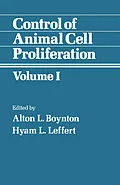Control of Animal Cell Proliferation, Volume I presents how animals regulate their proliferation activity and how cells become proliferatively autonomous resulting in malignant behavior. This book provides an understanding of mechanisms that control animal cell proliferation.
Organized into five parts encompassing 17 chapters, this volume begins with an overview of the efforts to elucidate he genetic alterations that lead normal cells to become cancer cells, which have been aided considerably by the investigation of acute retroviruses. This text then examines the factors involved in growth control. Other chapters describe in detail the biology and biochemistry of epidermal growth factor (EGF), which have been elucidated through the study of cultured human fibroblasts. This book discusses as well the protein kinases with specificity for tyrosine. The final chapter deals with regulation of initiation of eukaryotic protein synthesis by phosphorylation.
This book is a valuable resource for scientists as well as cellular and molecular biologists.
Inhalt
Contributors
Preface
I. Trends and Issues
1 Oncogenes and Pathways to Malignancy
I. Acute Transforming Retroviruses
II. Assignment of a Normal Function to a Proto-Oncogene
III. Specific Proto-Oncogene Rearrangements in Human Tumors
IV. Proto-Oncogene Amplification in Tumor Cells
V. DNA Insertion Can Lead to Oncogene Activation
VI. Oncogenes Demonstrated by Transfection of Human Tumor DNA
VII. Point Mutations Are Responsible for Activation of ras Oncogenes
VIII. Implications
References
2 The Role of Stem Cells in Normal and Malignant Tissue
I. Introduction
II. Stem Cell Renewal in Normal Tissues
III. Myelopoiesis
IV. Stem Cells in Tumors
V. The Clonal Hemopathies
VI. Lymphopoiesis and Acute Lymphoblastic Leukemia
VII. Heterogeneity
VIII. Molecular Considerations
IX. Treatment Goals
X. Conclusions
References
II. Growth Factors
3 Epidermal and Fibroblastic Growth Factor
I. Introduction
II. Epidermal Growth Factor
III. Fibroblast Growth Factor
IV. Conclusion
References
4 Insulin-Like Growth Factors
I. Introduction
II. Background
III. IGF Structure
IV. Biological Activity of Insulin-Like Growth Factors
V. Circulating and Secreted Forms of the IGFs
VI. Measurement of Insulin-Like Growth Factors
VII. Physiological Control of IGF Secretion
VIII. Unresolved Questions
References
5 Cyclic AMP Elevators Stimulate the Initiation of DNA Synthesis by Calcium-Deprived Rat Liver Cells
I. Introduction
II. Model System: The Ca2+-Deprived T51B Rat Liver Cell
III. Mechanism of Induction of DNA Synthesis by Ca2+
IV. Mechanism of Induction of DNA Synthesis by Tumor Promoters
V. Induction of DNA Synthesis by Other Cyclic AMP Elevators
VI. Stimulation of Cell Surface Protein Kinases
VII. Summary and Conclusions
References
6 Platelet Growth Factors: Presence and Biological Significance
I. Introduction
II. Platelet-Derived Growth Factor for Mesenchymal Cells
III. Growth Factors for Tumor Cells
IV. Concluding Remarks
References
III. Receptors
7 The EGF Receptor
I. Identification of the EGF Receptor
II. EGF-Induced Receptor Loss: Down-Regulation of the EGF Receptor
III. The Pathway of EGF-Induced Receptor Internalization
IV. A Cell Line Enriched in EGF Receptors
V. Tyrosine Kinase and the EGF Receptor
VI. Purification and Characterization of the EGF Receptor
VII. The EGF Receptor as Substrate
VIII. DNA Nicking Activity of the EGF Receptor
IX. Postulated Causal EGF-Mediated Response(s) in Stimulation of Cell Division
X. Modulation of the EGF Receptor by Endogenous and Exogenous Agents
XI. Sequence Homology between the EGF Receptor and the Avian Erythroblastosis Virus v-erb-B Oncogene Product
XII. The EGF Receptor Gene
XIII. The Future
References
8 Effect of Insulin on Growth in Vivo and Cells in Culture
I. Introduction
II. Insulin Growth Effects in Vivo
III. Insulin Growth Effects on Cells in Culture
IV. Mechanism of Insulin's Growth-Promoting Action
V. Post-Receptor Steps of Insulin's Growth Effects
VI. Summary
References
9 Glucagon Receptors and Their Functions
I. Introduction
II. General Characteristics of Glucagon Interaction with Its Receptors
III. Regulation of Adenylate Cyclase Activation by Glucagon
IV. Glucagon Structure-Function Relationships
V. Isolation and Purification of Glucagon Receptors
VI. Glucagon Interactions with Hormone-Sensitive Cells
VII. Concluding Remarks
References
10 The Platelet-Derived Growth Factor Receptor
I. Introduction
II. Specific and Nonspecific Binding
III. Basic Binding Properties of the PDGF Receptor
IV. The PDGF Binding Site Is a Functional Receptor
V. Variables Which Affect Expression or Properties of PDGF Receptors
VI. Physical and Biochemical Properties of the PDGF Receptor
VII. Subcellular Localization and Fate of Bound PDGF
References
IV. Transduction Mechanisms
11 The Role of Tyrosine Protein Kinases in the Action of Growth Factors
I. Introduction and Background
II. Substrates of the Growth-Factor Receptors
III. Methods of Detection
IV. Studies with Cell Cultures
V. p42
VI. Important Questions
References
12 The Control of Cell Proliferation by Calcium, Ca2+-Calmodulin, and Cyclic AMP
I. Introduction
II. Calcium, the Transitory Triggerer
III. The Cell Cycle-An Overview
IV. The Prereplicative Period
V. Conclusions
Addendum
References
13 Growth Regulation by Sodium Ion Influxes
I. Introduction
II. Experimental Aspects
III. Phenomenology of Growth-Related Sodium Influxes
IV. Evidence for Cause and Effect
V. Flux-Mediating Structures
VI. Functional Changes Linked to Sodium Influxes
VII. Conclusions
References
V. Regulation
14 Structural Heterogeneity of Duplex DNA
I. Introduction
II. Right-Handed Duplex DNA
III. Left-Handed Duplex DNA
IV. Cruciforms at Inverted Repeats
V. Summary
References
15 Initiation of DNA Replication in Eukaryotes
I. Introduction
II. Origins of DNA Replication
III. Replication Forks
IV. Extensive Single-Stranded Regions
V. DNA Polymerase-Primase Complexes
VI. Strand Separation Mechanism
VII. Replication and the Nuclear Matrix
VIII. Conclusion
References
16 Role of Phosphorylation of Nonhistone Proteins in the Regulation …
